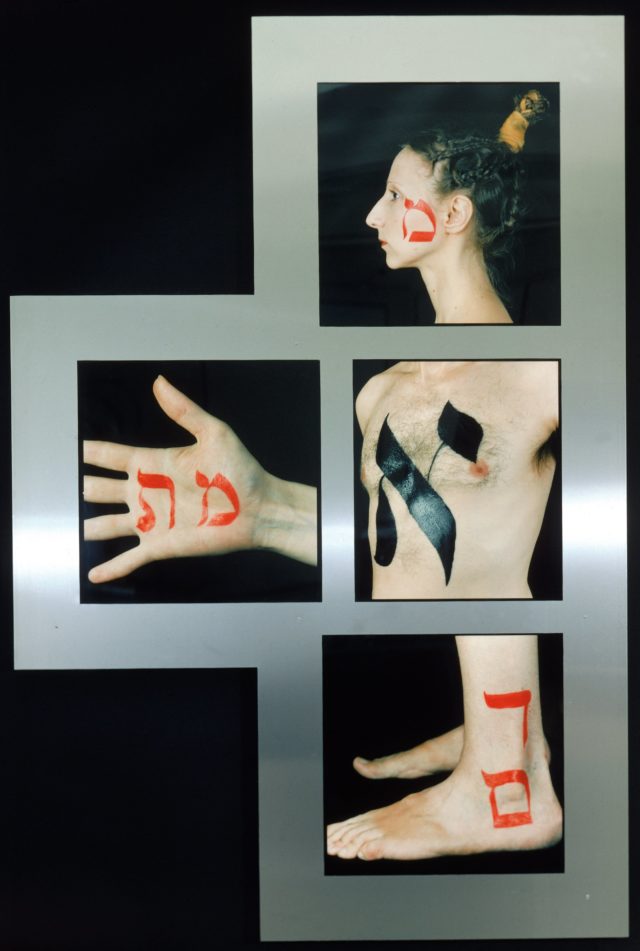
Joshua Abarbanel, Golem (maquette), 2013, Holz, Metall, Keramik. Image courtesy of the artist
Golem
Jewish Museum Berlin
September 23, 2016 to January 29, 2017
BERLIN — After wandering through “Golem”, the Jewish Museum Berlin’s occasionally insightful but too often flat meditation on the fabled creature of medieval European-Jewish folklore, I was left with a curiously empty feeling. Hardly what one expects from an exhibition depicting a monster of such long-standing and resonant legend; a homunculus whose story has influenced all things horrific from Mary Shelley’s novel Frankenstein to Disney/Marvel’s evil robot Ultron to those adorably gangly “grey aliens”.
For those of you unfamiliar with the story of the Golem, here are the cheat notes: in late 16th Century Prague, the beloved and wise rabbi Judah Loew ben Bezalel decided to create a monster/hero out of mud (a Golem, from the Hebrew portmanteau “galmi”, roughly meaning “of raw material”) to protect Prague’s Jewish population from persecution by Christians.
From that basic set-up, limitless variations have sprung. But the core of the story is always the same: a rabbi or some other wise elder creates a near-human monster, via a combination of righteous religiosity and magic, and the monster goes to work. In the majority of Golem stories, the creator of a Golem loses the ability to control their monster, and the monster becomes a metaphor for unrestrained human ambition, foolhardiness, and hubris.
The exhibition at the Jewish Museum Berlin uses the Golem as a starting point to talk about the inherent Golem-ness found in everything from information technology to biology to education. For instance, we build robots. Robots have the potential to take over the world. We study and attempt to mimic the replicative and reproductive systems of insects and other animals, and from that we will perhaps begin to clone ourselves. We learn and learn more, and yet we do not understand (which pretty much defines the fears of the Modern age).
The atomic bomb is a Golem. The internet is a Golem. The modern nation state is a Golem. Advances in reproductive technology could lead to wholesale Golem manufacturing. The push-pull of the Golem mythology, the exhibition teaches, the tension between advancing knowledge and unregulated power is everywhere; and we entertain ourselves with depictions of the monstrous in order to distil our subsequent massive anxieties down to more manageable sizes.

‘Golem II’, Rimma Gerlovina, Mark Berghash, Valeriy Gerlovin, USA, 1987, Chromogene Farbfotografie auf Aluminium. Image: Gerlovina, Berghash, Gerlovin, 1987, The Jewish Museum, New York
The problem with this potentially revelatory exhibition, however, is twofold. First, many of the works (some commissioned for the show, some made decades before) are mediocre. Rimma Gerlovina’s, Mark Berghash’s, and Valeriy Gerlovin’s collaborative photo-sculpture, wherein framed individual images of body parts decorated with Hebrew letters are stacked to create a whole body, is just boring, obvious (we are all Golems inside!) and reminded me of bad 80s body-identity art.
Meanwhile, Charles Simond’s 1970 filmed performance, wherein the artist emerged from a mud pit to represent the birth of man, is actually more closely linked to the story of Adam than the Golem. And the depictions of recent advances in Japanese robotics are uncanny not because the robots are monstrous or markedly other, as a Golem is, but because they look so much like actual people. The robots are not monsters, they’re just future office workers.
To be fair, I did quite like the many toys on display, mostly characters from gaming culture, action figures that employ the same lunkish and clumsy physiognomy as the traditional block-headed Golem. The samples of Golem characters that have appeared in comic books (as both heroes and villains) are fun too. And the show’s centrepiece, Joshua Abarbanel’s spectacular multi-media sculpture – a bigger-than- life Golem made of overlapping, clumped ceramic Hebrew letters – is worth the ticket price alone. It is a gorgeous, meticulously crafted work that inspires a sense of wonder (just what the entire show sorely needs). I was equally happy to linger over the archival documents from Paul Wegener’s 1920 film Der Golem—easily the most lasting depiction of the monster nearly 100 years on. Wegener created three Golem films, one even a romantic comedy, but his 1920 film is the only one preserved in its entirety. Its visual cleverness and humanising of the monster has been referenced by everyone from James Whale (in his version of Frankenstein) to the makers of the Slender Man mythos.
The poverty of inspiring interpretations aside (the faves list above are really the outliers in a crop of bland pieces), a far larger problem hangs over this uneven and frustrating exhibition. Namely, the monster upon whom the entire show is built gets so little actual consideration. Does a Golem think, feel, have needs? Can a Golem love? I know that sounds a bit silly at first glance, but are not our most effective depictions of the monstrous those wherein the humanity of the monster (and thus a part of us) is revealed?
The Golem of legend is a monster because it breaks away from its master/creator and wreaks havoc – or, in contemporary psychology terms, because it develops a sense of its own agency. The monster is only effective as a frightening entity or a lesson-bearing spectacle when it is too close to our own desires for our comfort; when it in some way becomes a projection of our own anxieties, tendencies, or baser instincts.
As presented by the Jewish Museum Berlin, the Golem is all metaphor and no guts.The show’s obsession with equating contemporary concerns over rapid technological advancement with the creation myth (and morality tale) of the Golem seems obvious enough to merit maybe one section, but not repeated messaging. And certainly not an embarrassingly cloying FaceRig with a cheap version of Wegener’s masterful makeup job on the receiving screen. Fun for the whole family!

We get it already. Because of this relentless search for contemporary parallels to the Golem story (a Trump campaign “Make America Great Again” ball cap is on display here, looking as cheap as the metaphorical linkage that inspired its inclusion), there is almost no feeling for the great creature itself, for the wonder it has inspired, in this timid and untheatrical exhibition. The show lacks magic, a necessary otherworldliness, the delicious medieval alchemy of the sacred and the profane.
Mild academicizing around and about the creature, a reading of its story as a template for so-very-now concerns, replaces any insight into the creature as a figure with its own dynamic and chaotic story to tell. We are told over and over via the didactics how relevant the Golem story is today, but we are not shown either the creature’s legendary power, for good or for evil, nor enough concretizations of the terror and love its many narratives have inspired over generations. And without enough works to prompt these associations, all the projecting seems at best well-intentioned and at worst flimsy.
The Golem tale, after all, comes from an era we can not easily comprehend now, a time when people felt a direct and awful (in the old sense of the word) relationship to the divine and the demonic. And yet the show is about as engaged with the mystical as an appliance dealers’ convention.
Don’t ask me to come to a show about a magical monster and then show me a fucking Trump ballcap and some twaddle about the limitless power of the internet. I’ve been to the synagogue in Prague where the Golem is believed to be hidden, and just standing outside that otherwise unremarkable little temple with a takeaway cup of coffee in my hand was more transcendent than this feeble show.
The Golem as revealed in this bloodless exhibition is more mud than man, or even mudman. I felt lonely and a bit embarrassed for the poor stumbling bastard: held up as a specimen of so many things outside of its unique narrative yet presented as utterly vacant in and of itself.
The Golem is a potent mythological creature, a menace and a friend, an aspirational anti-hero. It deserves centre stage.


Comments on this entry are closed.